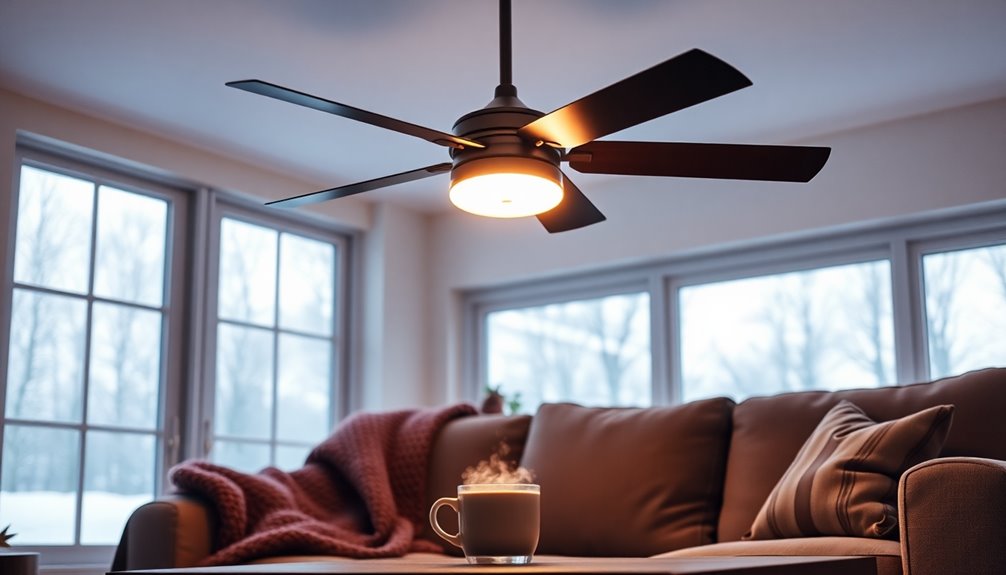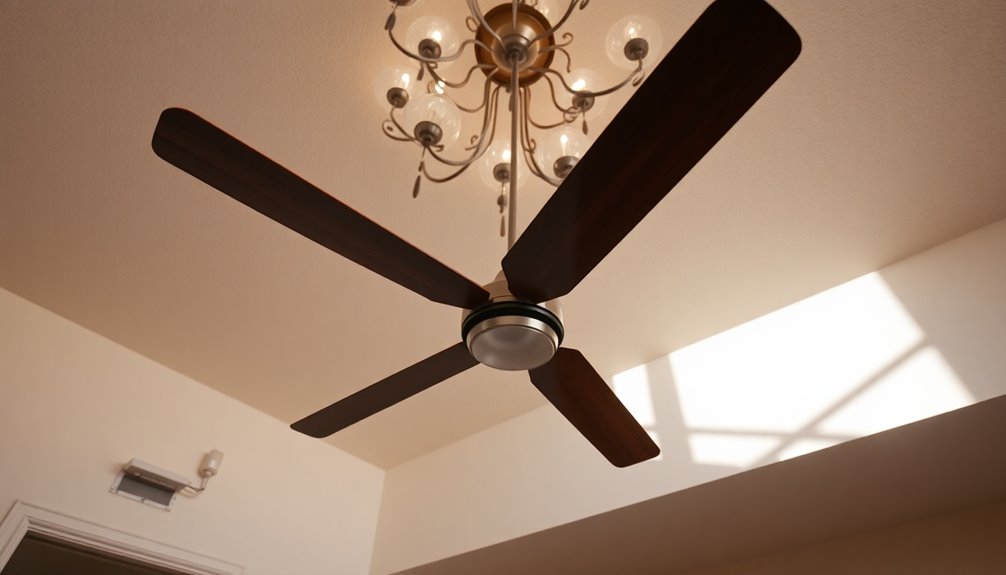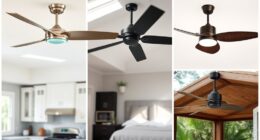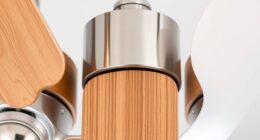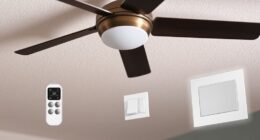Yes, you can definitely put a ceiling fan in your kitchen. It helps circulate air, reduce humidity, and dissipate cooking odors. However, you should be cautious about installation, ensuring it meets local building codes. A fan near open flames can pose a fire hazard. Keep in mind that ceiling fans might not provide adequate lighting for food prep areas. If you choose to install one, regular maintenance is essential to keep it free of grease and dust. There are also other great ventilation options to take into account, and you might want to learn more about them.
Key Takeaways
- Yes, you can install a ceiling fan in the kitchen, but consider local building codes and clearance requirements for safety.
- Ensure the ceiling height is at least 7 to 8 feet for safe operation and effective airflow.
- A minimum CFM rating of 4,000 is recommended for effective air circulation in kitchen spaces.
- Regular maintenance, including cleaning blades, is essential to prevent grease and dust buildup in kitchen environments.
- Ceiling fans can enhance air circulation but may not provide sufficient lighting for cooking, so consider integrated lighting options.
Benefits of Ceiling Fans
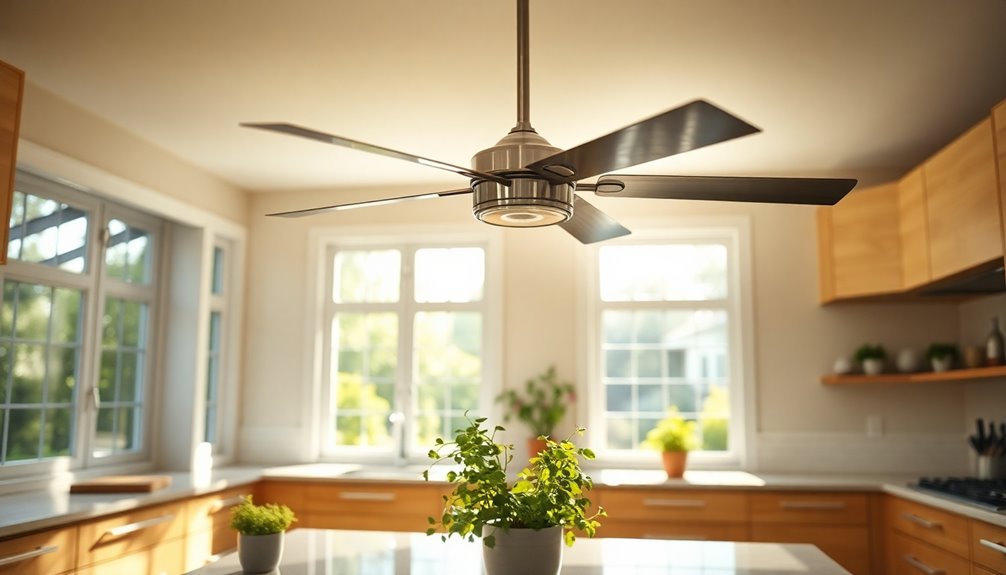
When you install a ceiling fan in your kitchen, you not only enhance air circulation but also create a more comfortable cooking and dining environment.
One of the primary benefits of installing a ceiling fan is its ability to improve air circulation. It helps to reduce hot spots and humidity levels, making your kitchen a pleasant space to prepare meals and gather with family and friends. Additionally, energy-efficient models can significantly lower your electricity bills, making it a smart investment for homeowners. Moreover, modern fans are Energy Star certified, ensuring they operate efficiently and contribute to energy savings.
Additionally, ceiling fans can help dissipate cooking odors more quickly, resulting in better air quality. Unlike air conditioning, they operate at a lower cost, allowing you to save on energy bills while keeping your home comfortable. By using a ceiling fan, you can set your thermostat higher, enhancing your home's energy efficiency.
Many ceiling fans also come with integrated lighting options, providing extra illumination while cooling the area. Plus, the breezy environment they create can deter pests like flies, further improving your kitchen experience. Furthermore, air quality improvements can lead to better overall health and comfort in your kitchen space.
Potential Drawbacks
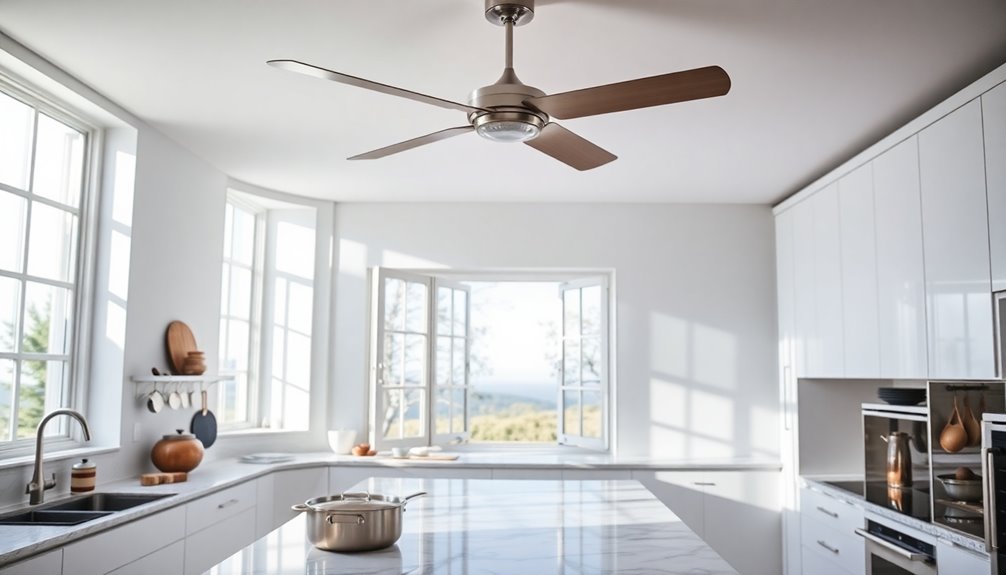
Installing a ceiling fan in your kitchen might seem like a great idea, but there are potential drawbacks to weigh. One significant concern is safety; having a ceiling fan near open flames or gas stoves can increase the risk of fire hazards. Additionally, while a ceiling fan helps with air circulation, it often provides insufficient lighting for cooking and prep areas, which means you'll likely need extra light sources.
Noise is another factor to evaluate. A ceiling fan can add extra sound to an already busy kitchen, making it distracting during cooking or dining. Plus, many people view ceiling fans as outdated, which could negatively impact your kitchen's aesthetic.
Lastly, maintenance can be a hassle. Ceiling fans accumulate grease and dust quickly, requiring regular cleaning to keep them functioning properly. This can become labor-intensive in a kitchen setting.
Here's a quick overview of these concerns:
| Drawback | Description |
|---|---|
| Fire Hazard | Risk of flames if near stoves |
| Insufficient Lighting | May need additional light sources |
| Noise | Adds distraction in a busy environment |
| Maintenance | Requires regular cleaning from grease and dust |
Alternatives for Ventilation

If ceiling fans aren't cutting it for your kitchen ventilation, there are plenty of alternatives to evaluate.
Range hoods effectively remove smoke and odors, while exhaust fans can help manage heat and moisture.
You might also find portable fans useful for flexible airflow without the need for permanent installation.
Range Hood Options
For effective kitchen ventilation, range hoods stand out as the go-to solution, offering a variety of options to suit your cooking style and kitchen layout. Unlike a ceiling fan, which circulates air, a range hood is specifically designed to eliminate smoke, grease, and odors that arise during cooking. Proper installation of a range hood can significantly enhance energy efficiency in your kitchen. Additionally, investing in a high-quality range hood can save you money in the long run by reducing the need for expensive repairs caused by grease buildup.
You can choose from different styles, including wall-mounted, under-cabinet, and island models, ensuring compatibility with your space. Depending on your cooking needs, many range hoods feature powerful exhaust fans, moving air at rates from 200 to over 1,200 CFM, effectively keeping your kitchen fresh.
Additionally, some range hoods come with added features like built-in lighting, multiple fan speeds, and sound-dampening technology, making your cooking experience more enjoyable. Moreover, integrating a smart home device with your range hood can enhance its functionality by allowing remote control and monitoring.
If you're concerned about ductwork, ducted range hoods vent air outside while ductless models use filters to recirculate air back into your kitchen, providing flexibility for any home setup.
Choosing the right range hood can greatly enhance your kitchen's ventilation, making it more comfortable and efficient while you cook.
Exhaust Fan Solutions
Exhaust fans serve as efficient alternatives for kitchen ventilation, removing smoke, heat, and odors directly from the source. Unlike ceiling fans, exhaust fans provide targeted ventilation, making them more effective in maintaining a comfortable cooking environment.
You can install these fans in windows or ducts, which helps expel excess moisture and improve indoor air quality in kitchens. Ductless exhaust systems are another great option, as they offer air purification without the need for extensive installation. This flexibility allows you to find the perfect fit for your kitchen space. Regular use of exhaust fans can lead to improved respiratory health, particularly in areas where cooking odors and pollutants can accumulate. Additionally, maintaining good oral hygiene is essential, as poor air quality can indirectly affect overall health. Furthermore, utilizing an exhaust fan can enhance your home's energy efficiency, as it helps regulate temperature and reduce the strain on cooling systems. Air purifiers can complement exhaust fans by further improving air quality in your home.
When properly sized, exhaust fans can reduce humidity levels by up to 50%, preventing the growth of mold and mildew in cooking areas. Many modern exhaust fans come with useful features like timer settings and variable speeds, enhancing functionality and energy efficiency compared to traditional ceiling fans. Additionally, installing an exhaust fan can help maintain a clean and safe environment in your kitchen, similar to the importance of regular maintenance for wood stoves.
Portable Fan Usage**
A portable fan can be a game-changer for kitchen ventilation, offering flexibility and convenience when you need it most.
Whether you're whipping up a quick meal or hosting a dinner party, these fans can greatly enhance your cooking experience. They're easy to move around, allowing you to direct airflow exactly where it's needed to combat cooking odors and dissipate heat.
Here are three reasons to reflect on using portable fans in your kitchen:
- Energy-efficient: Portable fans consume less power than central air conditioning, helping you save on energy bills while keeping the kitchen comfortable.
- Customizable airflow: With adjustable speed settings, you can tailor the fan's output based on your personal comfort while cooking.
- Low maintenance: Unlike ceiling fans, portable fans require minimal upkeep. You can simply unplug them and wipe them down without any complex installation. Additionally, they can effectively complement the best vacuums for dust removal in maintaining a clean kitchen environment.
Maintenance Requirements

Over time, the maintenance of ceiling fans in kitchens becomes vital due to their exposure to grease and dust from cooking. Unlike fans in other areas, kitchen fans require more frequent cleaning to guarantee peak performance and air quality.
It's a good idea to wipe down the fan blades at least once a month to prevent the buildup of cooking residues. Neglecting this can compromise airflow efficiency and lead to higher energy consumption, which isn't ideal for your utility bills.
Additionally, regular checks for wear and tear are important in the harsh kitchen environment. You should inspect the electrical connections and listen for any unusual noises, as these can indicate accumulated dirt or mechanical issues that need addressing.
Keeping your ceiling fan clean and well-maintained not only prolongs its lifespan but also enhances its efficiency, helping circulate air effectively.
Installation Considerations
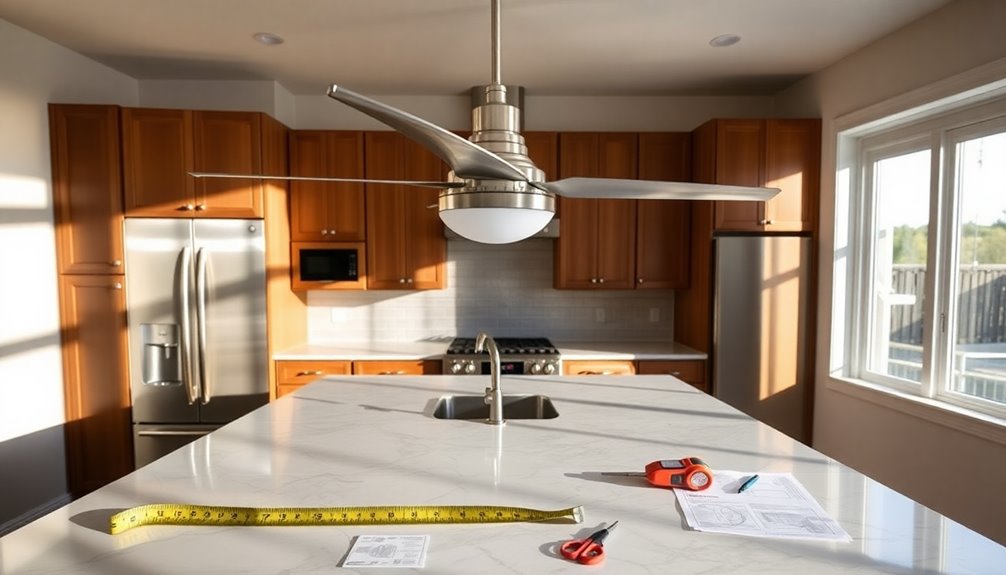
When installing a ceiling fan in your kitchen, you need to take into account the ceiling height to guarantee safe operation.
You should also check local building codes and electrical installation needs to comply with regulations.
Taking these factors into view will help you achieve ideal airflow and functionality.
Ceiling Height Requirements
Installing a ceiling fan in your kitchen requires careful attention to height requirements to guarantee safety and efficiency. Making sure the fan is properly positioned not only enhances functionality but also helps maintain ideal airflow throughout your space. Here are some key points to take into account:
- Clearance Above Floor: Aim for a minimum height of 7 to 8 feet from the floor to the fan blades. This prevents obstruction and allows safe clearance for occupants.
- Wall Clearance: Maintain at least 18 inches of space between the fan blades and the nearest wall. This is essential for ideal airflow and effective fan operation.
- Vaulted Ceilings: If you have a vaulted ceiling, use a downrod to mount the fan, keeping it 8 to 9 feet above the floor. This guarantees the fan operates efficiently and remains at a safe height.
Don't forget to take into account the total height of the fan, including light fixtures, to make sure it doesn't hang too low in your kitchen space.
Finally, always check local building codes for specific ceiling height requirements before installing a ceiling fan.
Electrical Installation Needs
Having established the importance of proper ceiling height, the next step involves understanding the electrical installation needs for your kitchen ceiling fan. Depending on your kitchen's existing setup, you may need to perform some electrical work to guarantee a safe and efficient installation. This could involve upgrading your wiring or adding new circuits to meet the fan's power requirements.
Make certain to take into account the installation requirements specific to ceiling fans. Heavier models may necessitate additional support from your ceiling structure to prevent any accidents. You want to guarantee that your fan is securely mounted and can operate safely without risk of falling or causing damage.
Professional installation is often recommended, as it helps meet safety standards and minimizes potential electrical hazards when connecting the fan to the power supply.
A qualified electrician can guarantee that all electrical work is done correctly, adhering to the necessary guidelines. This not only protects your home but also guarantees your ceiling fan runs smoothly and efficiently, enhancing the comfort of your kitchen space.
Local Building Codes
Local building codes play an essential role in guaranteeing the safe and efficient installation of ceiling fans in your kitchen. These codes are designed to protect you and your home from potential hazards.
Before you start your installation, keep the following considerations in mind:
- Clearance Heights: Confirm your ceiling fan is installed at the required height to avoid obstruction from kitchen fixtures or occupants. This helps maintain safety and comfort in your space.
- Damp or Wet Ratings: Check local regulations to see if you need a fan rated for damp or wet locations. Kitchens often have moisture, so using the right fan is vital for safety and efficiency.
- Dedicated Circuits: Many electrical codes require that ceiling fans be installed on a dedicated circuit. This prevents overloading existing wiring, guaranteeing safety and compliance with local building codes.
Before proceeding with your installation, consult local building authorities or a licensed contractor to confirm you meet all regulations.
Staying informed can save you from costly mistakes and guarantee a safe environment in your kitchen.
Choosing the Right Fan
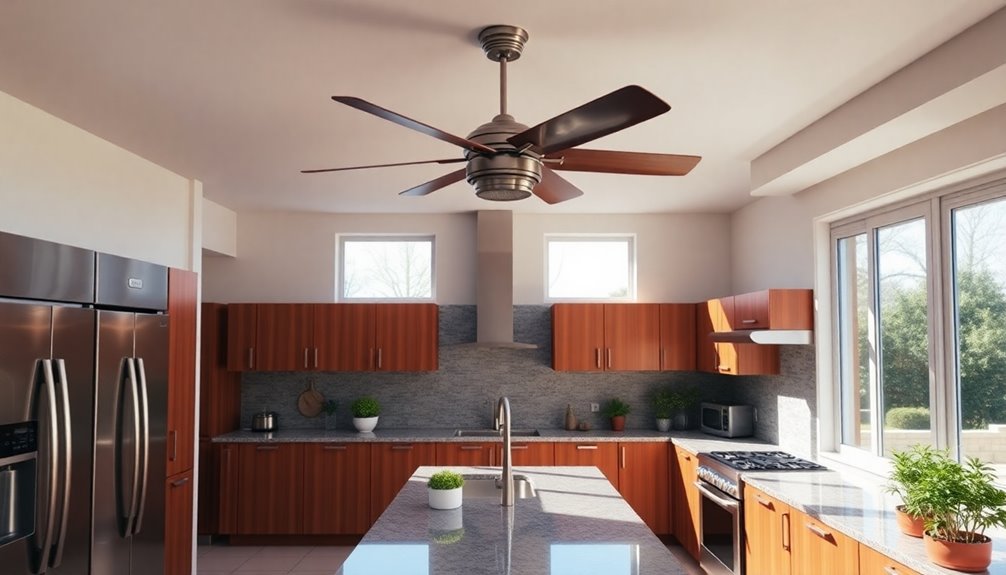
Selecting the right ceiling fan for your kitchen can greatly enhance comfort and functionality. Start by considering the size of your kitchen. A fan with a blade span of 36 to 54 inches is typically ideal for most kitchens. Next, focus on the fan's CFM (cubic feet per minute) rating; you should aim for at least 4,000 CFM to guarantee effective air circulation, especially during cooking.
Additionally, choose materials that resist grease accumulation and are easy to clean, like stainless steel or plastic. This will help minimize maintenance efforts. Don't forget about ceiling height; your fan should be installed at least 7 feet above the floor to guarantee proper airflow without obstruction. Regular maintenance can help prevent dangerous situations that may arise from ceiling fan issues.
Lastly, look for added features like integrated lighting options or remote control capabilities for convenience. Here's a simple table to help you with your selection:
| Feature | Recommendation |
|---|---|
| Blade Span | 36 to 54 inches |
| Minimum CFM | At least 4,000 CFM |
| Material | Stainless steel or plastic |
| Ceiling Height | At least 7 feet |
| Additional Features | Lighting/remote control
Personal Experiences and Opinions
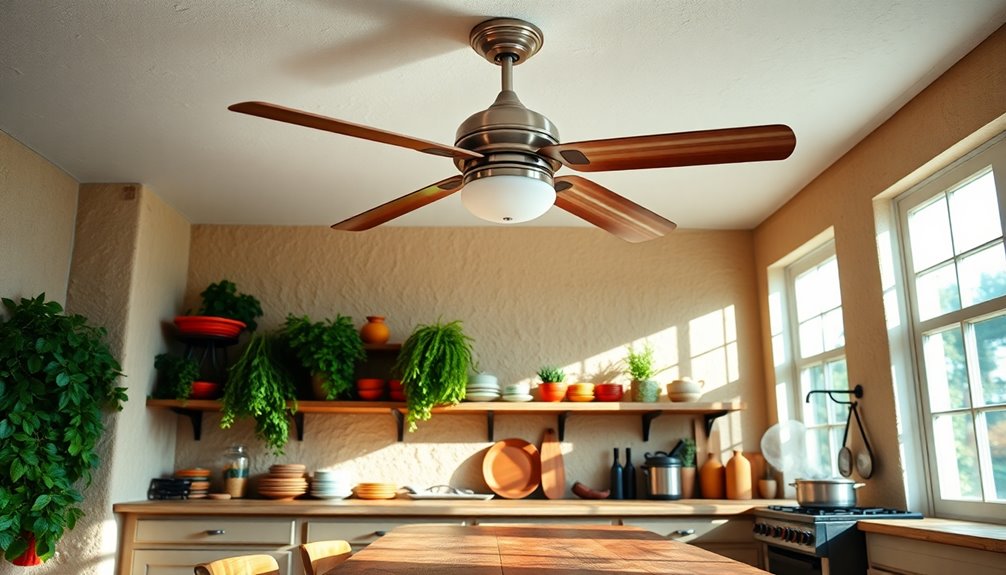
Installing a ceiling fan in your kitchen can transform the space in ways you mightn't expect. Many homeowners who've made this change rave about the improvement in air circulation, especially while cooking.
You might find that a well-placed ceiling fan not only keeps you cool but also helps whisk away those pesky cooking odors that linger after a meal.
Here are some personal experiences and opinions from users like you:
- Enhanced Comfort: You'll notice a significant difference in comfort levels during cooking, making meal prep less of a chore.
- Odor Control: Many users report that their ceiling fans effectively dissipate cooking odors, especially after the occasional burnt dish.
- Dual Functionality: A ceiling fan offers both airflow and lighting, creating a more inviting atmosphere for cooking and gatherings.
Despite initial concerns about aesthetics, most homeowners express that they wouldn't want to remove their ceiling fans due to the functional benefits they provide. Additionally, using a ceiling fan can complement energy-saving features, enhancing the overall energy efficiency of your kitchen environment.
Frequently Asked Questions
Do People Still Put Ceiling Fans in Kitchens?
Yes, people still install ceiling fans in kitchens. They provide excellent air circulation, helping to dissipate cooking odors and reduce humidity while you cook.
You'll find modern designs that fit various kitchen styles, making them both functional and aesthetically appealing. In warmer climates, ceiling fans create a gentle breeze, increasing comfort during meal prep and dining.
Plus, they're a cost-effective alternative to air conditioning, especially during hot summer months.
Is It a Good Idea to Have a Fan in the Kitchen?
Having a fan in the kitchen can be like adding a refreshing change to your cooking space.
It enhances air circulation, keeping the environment cool and comfortable while you whip up your favorite dishes. Plus, it's an energy-efficient alternative to air conditioning, saving you some cash.
Just remember, regular maintenance is key to keep it running smoothly.
Weigh your preferences and kitchen layout to decide if it's the right fit for you.
Can I Put a Ceiling Fan in a Kitchen?
Yes, you can install a ceiling fan in your kitchen.
Just make sure to take into account your kitchen's layout and ceiling height for proper airflow.
Choose a fan that's easy to clean since grease and dust can accumulate quickly.
While a ceiling fan improves air circulation and comfort, remember it mightn't be as effective as a dedicated exhaust system for removing smoke and heat.
Always check local building codes before installation.
Can You Use a Ceiling Fan Instead of a Range Hood?
You might think using a ceiling fan instead of a range hood is a smart move, but it's not quite that simple.
While ceiling fans circulate air and can help with comfort, they won't effectively remove smoke, heat, or grease from your cooking.
You need the targeted ventilation a range hood provides.
For the best results, consider combining both to guarantee your kitchen stays fresh and your cooking experience remains enjoyable.
Conclusion
In the end, adding a ceiling fan to your kitchen can be a game-changer. Imagine whipping up a meal while a gentle breeze cools you down, making cooking feel like a breeze. However, think about the space, style, and maintenance before you plunge into it. With the right fan, you'll not only enhance your kitchen's comfort but also elevate its look. So, weigh the pros and cons, and let your kitchen breeze with creativity and efficiency!


